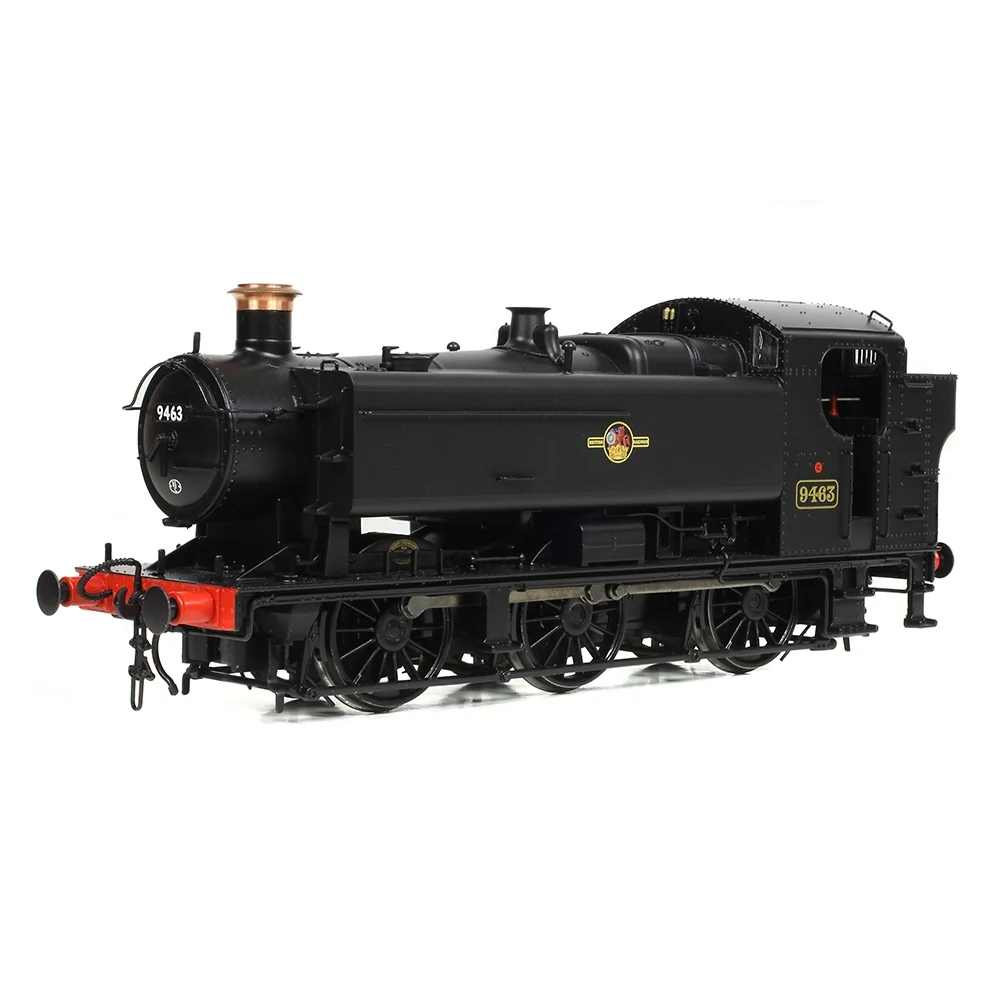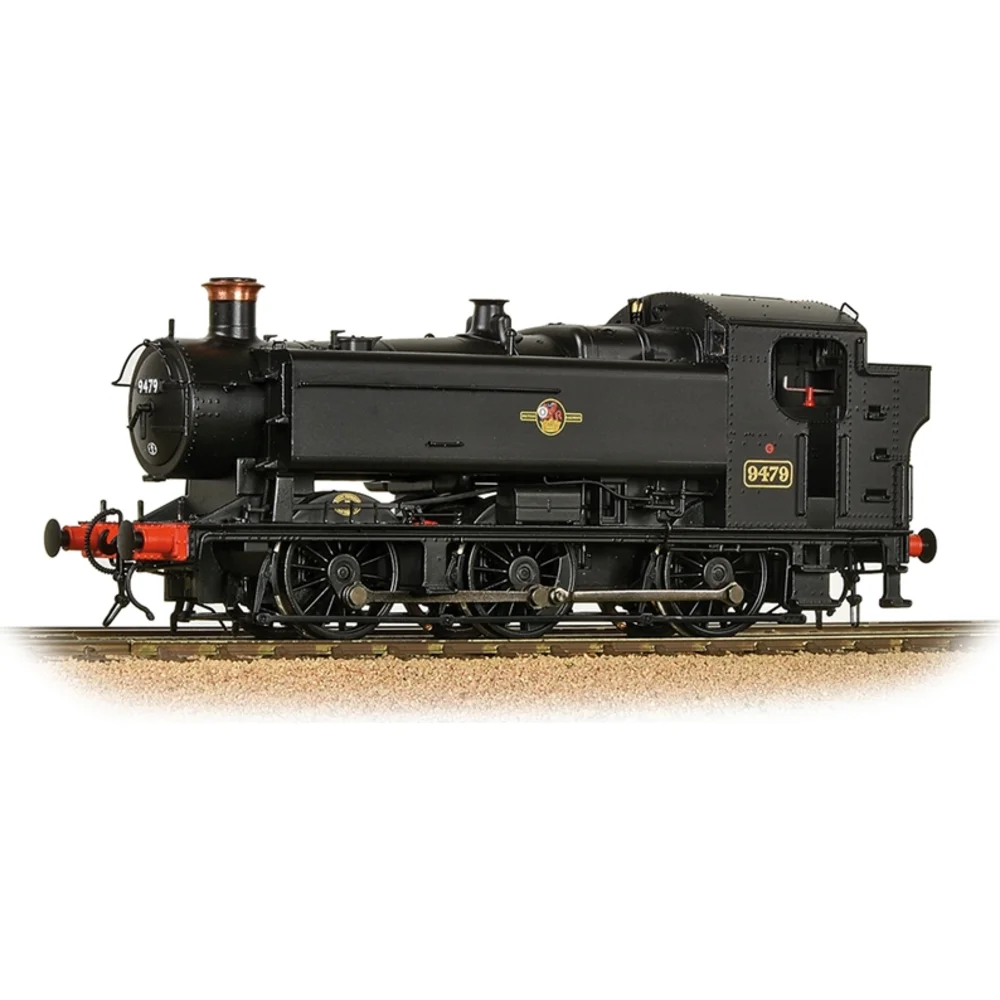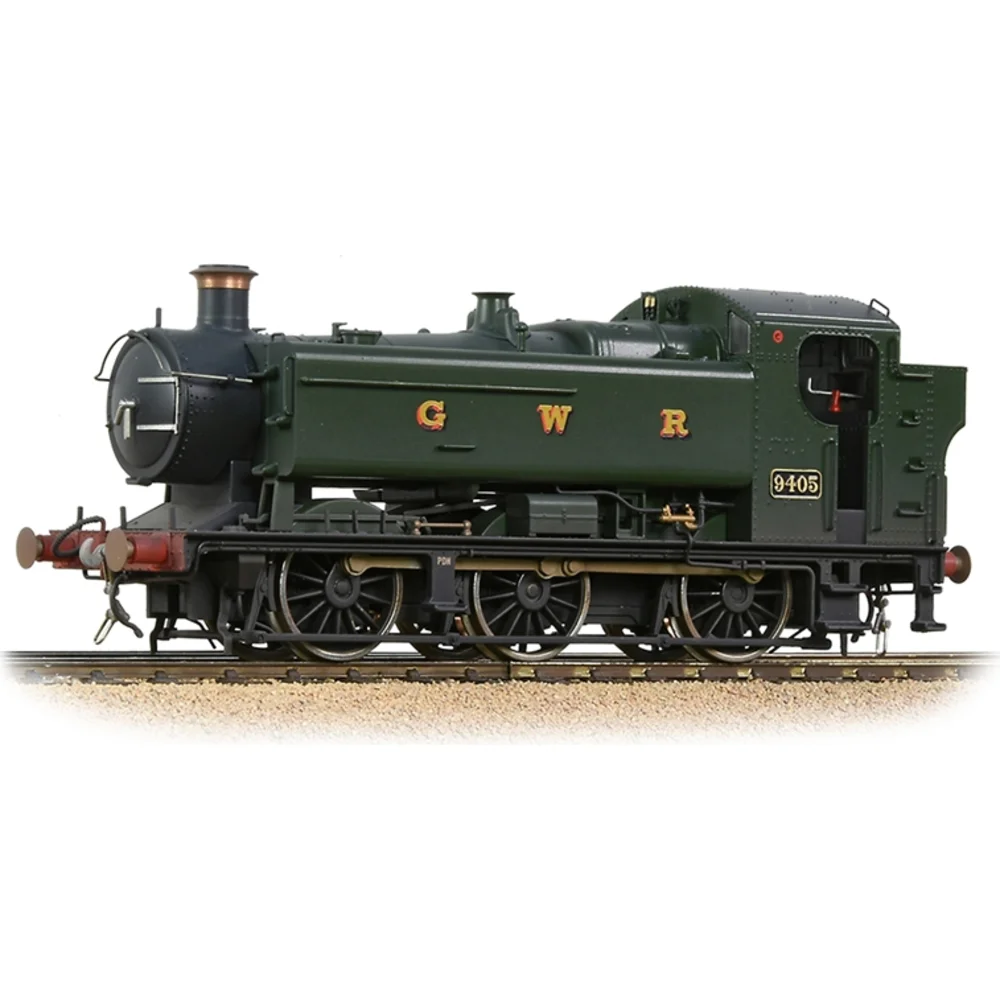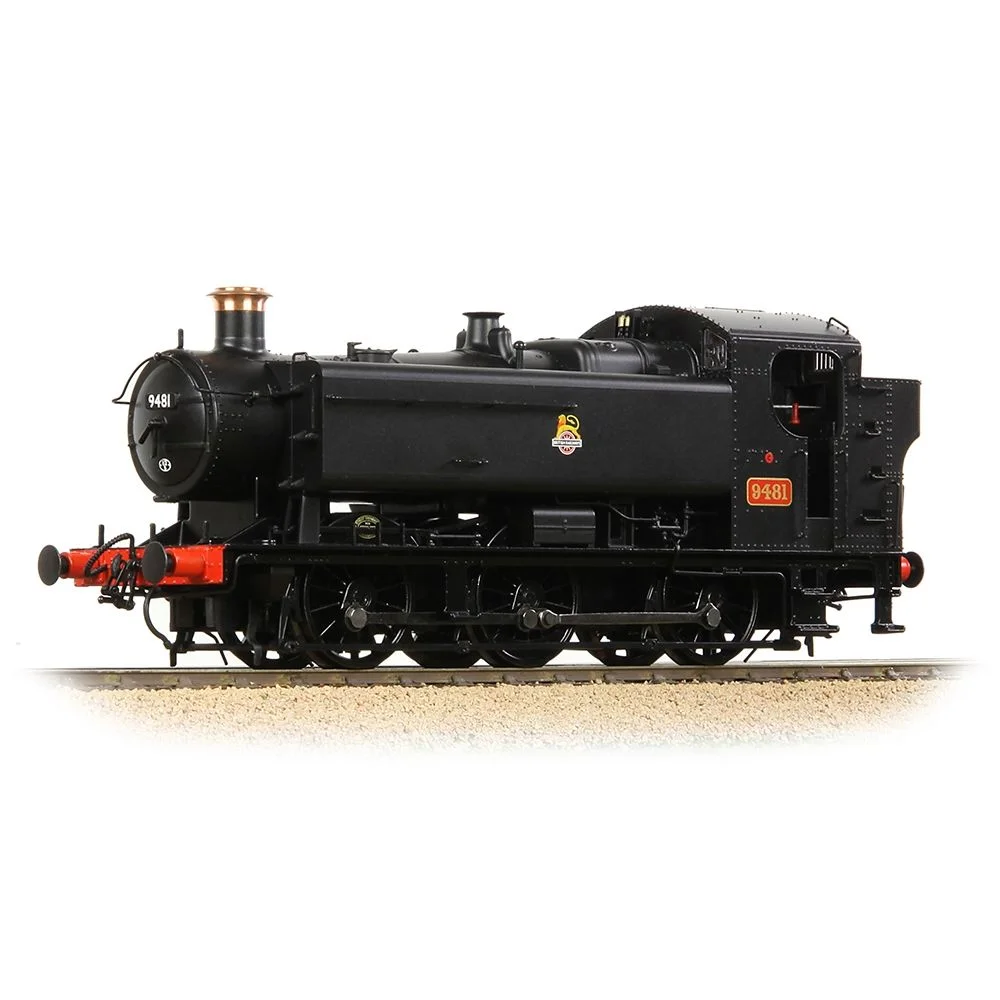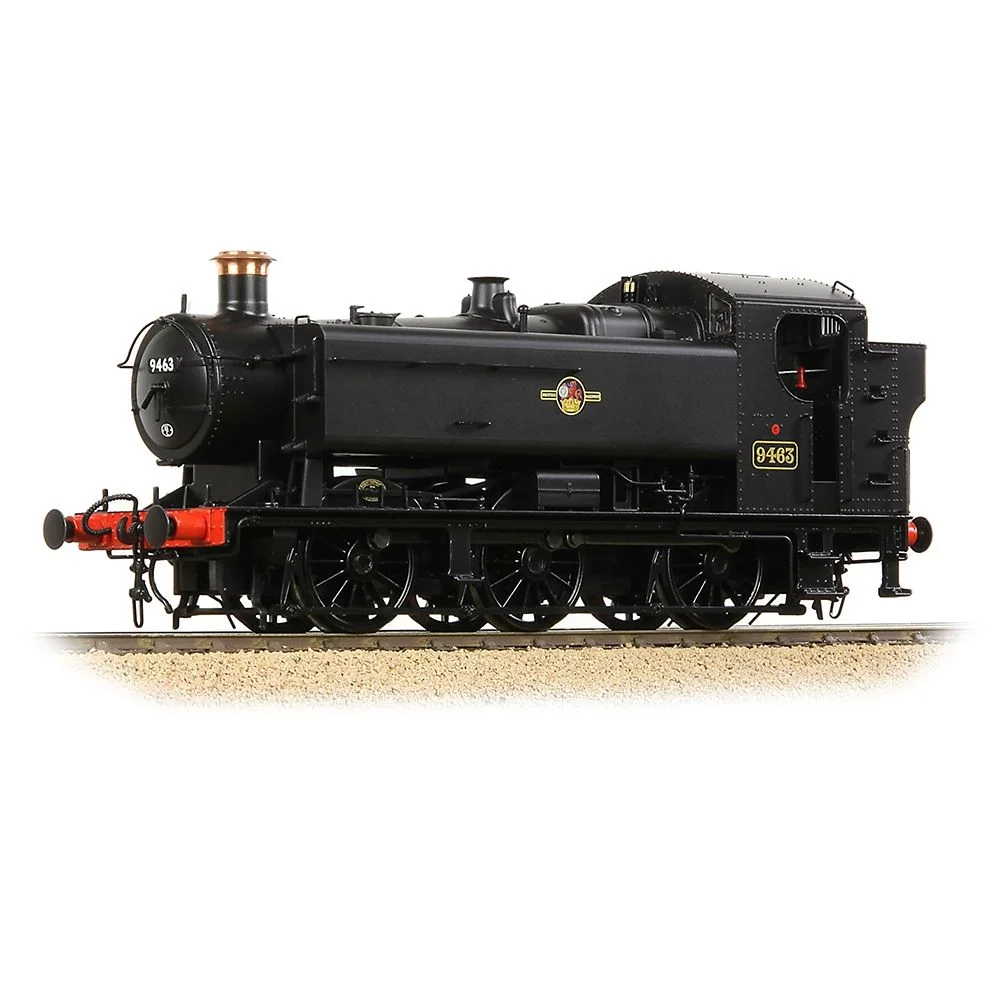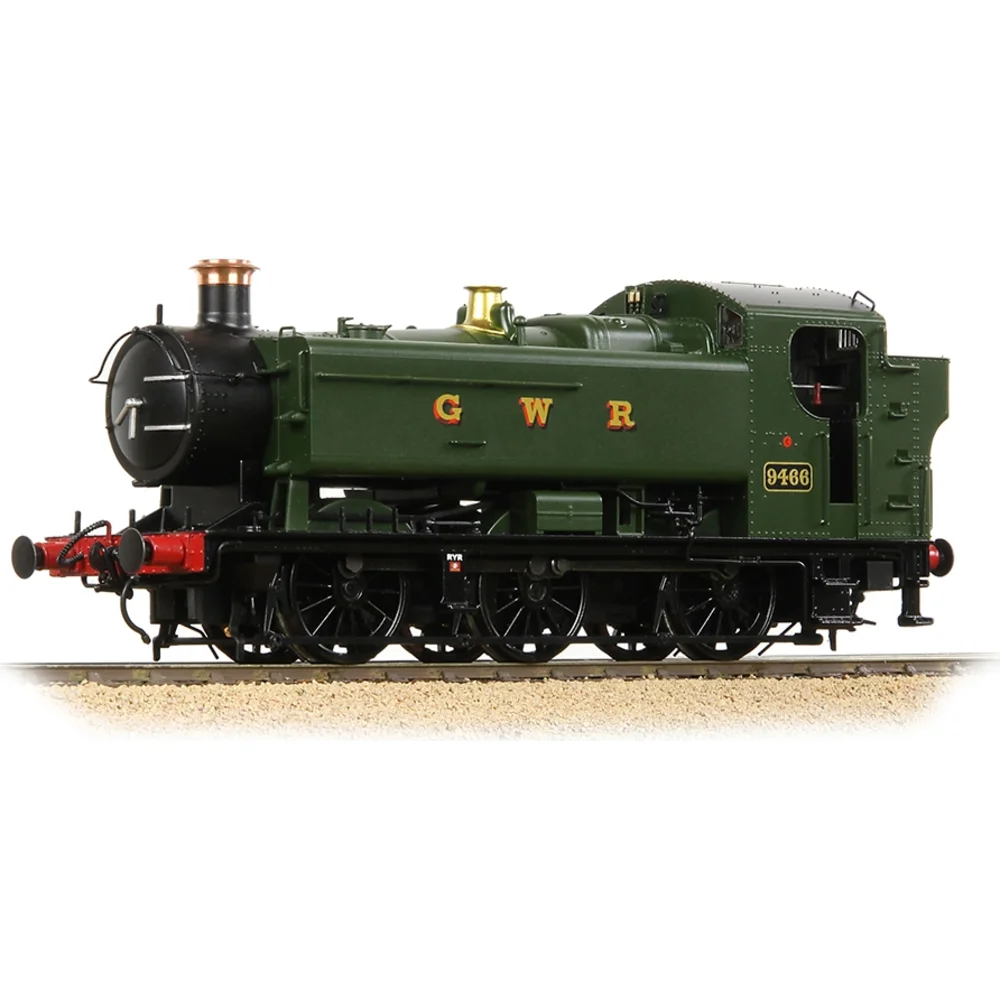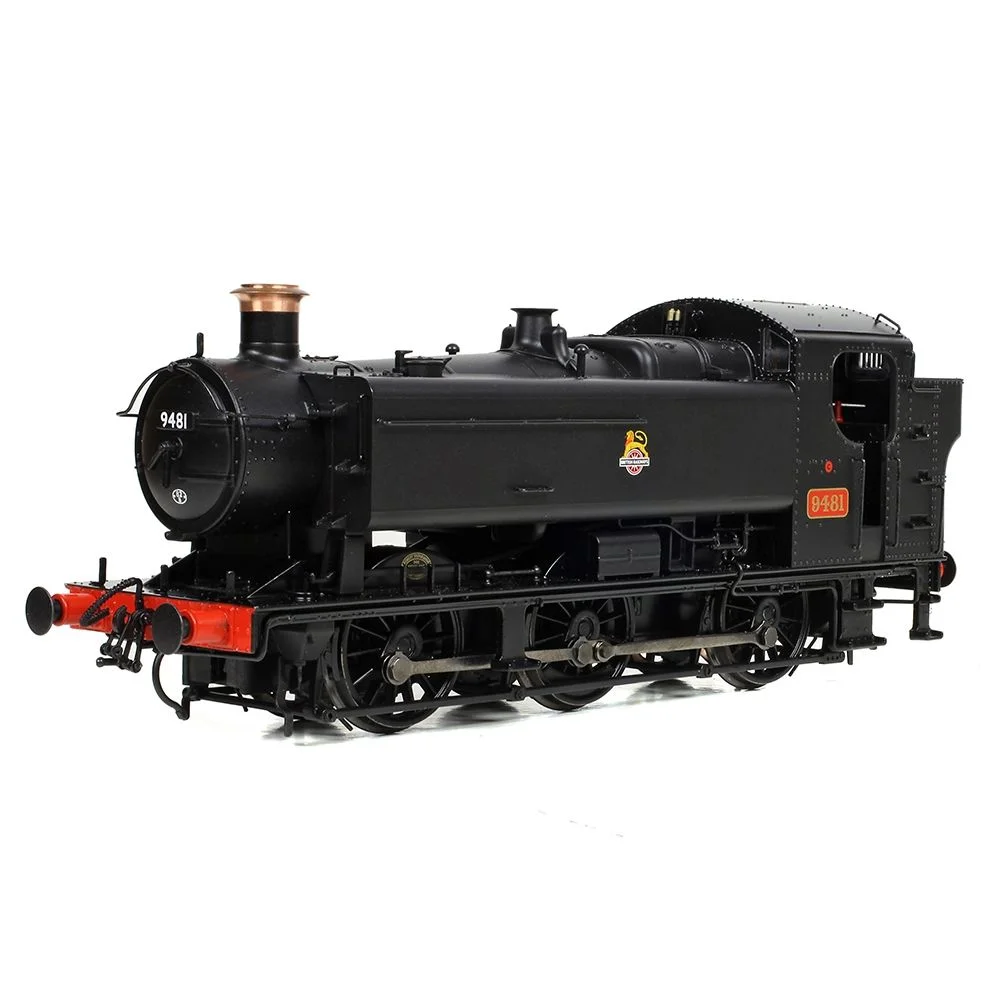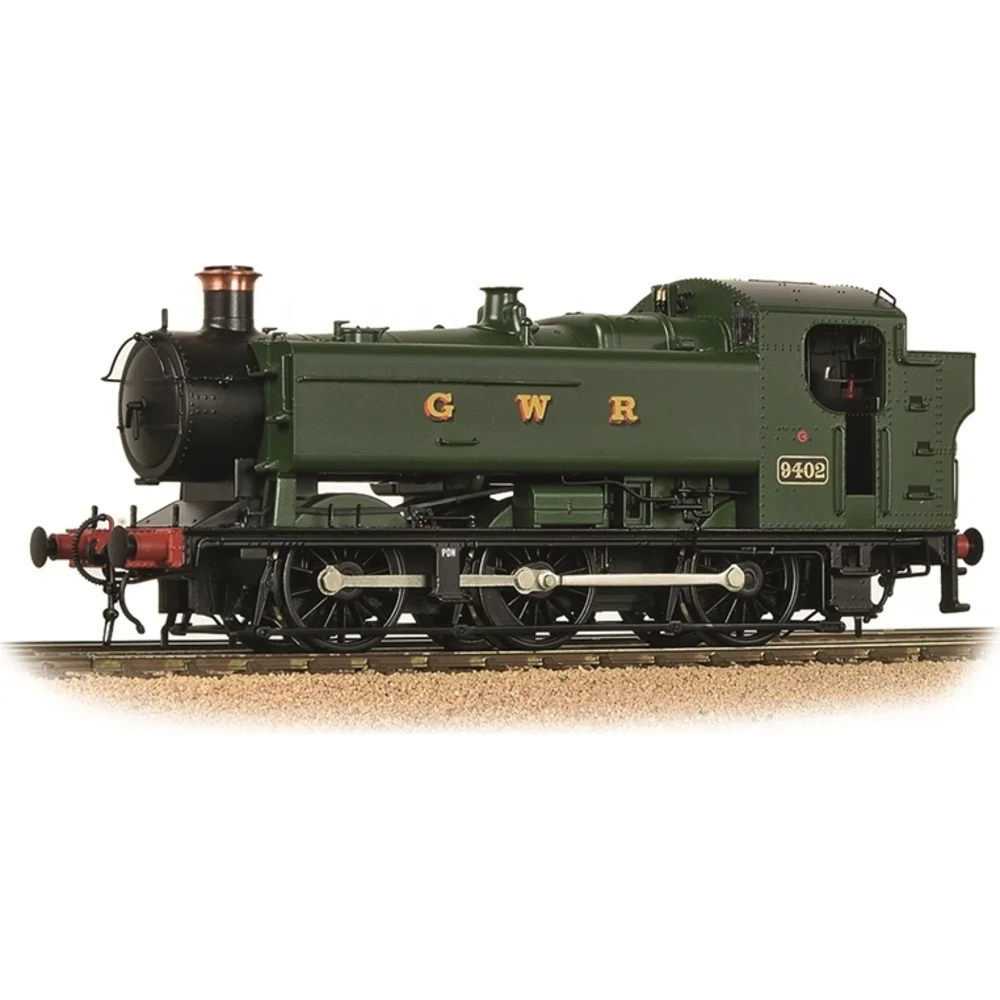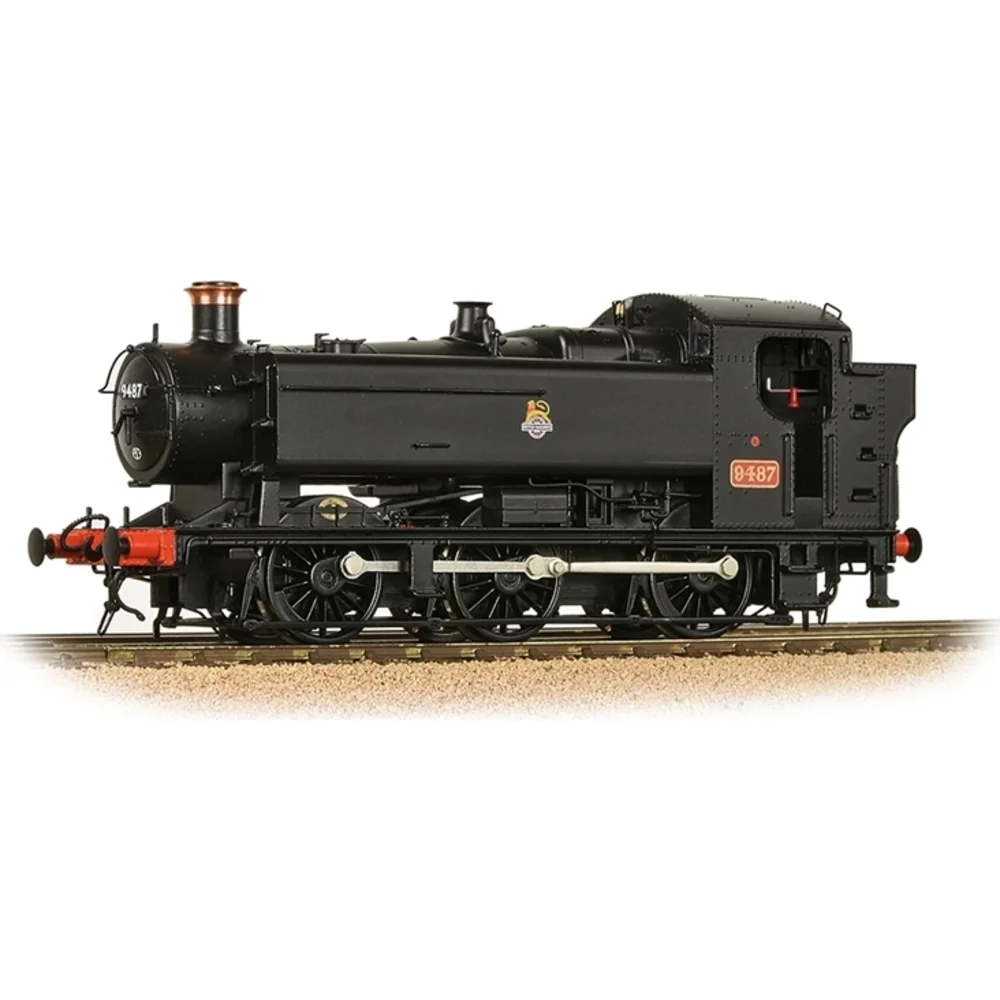GWR 9400 Class: The Final Chapter in Pannier Tank Evolution
Contents
- Historical Background and Context
- Design and Technical Specifications
- Service History and Operations
- Withdrawal/Preservation/Legacy
- Modelling Significance and Scale Replications
- Unique Modelling Tips and Layout Integration
- Technical Innovation and Engineering Legacy
- Cultural Impact and Popular Recognition
- Finally
- Frequently Asked Questions
- eBay Listings
The GWR 9400 Class represents both a culmination and a contradiction in British locomotive history. As the last steam locomotives designed by the Great Western Railway and the final development in a lineage stretching back to the 1870s, these powerful 0-6-0 pannier tanks embodied decades of refined engineering expertise. Yet they also became symbols of technological transition, with most having tragically short working lives as diesel traction rapidly replaced steam power in the 1950s and 1960s.
Designed under Frederick Hawksworth's leadership as enlarged, more powerful successors to the legendary 5700 Class, the 9400s incorporated advanced features including taper boilers shared with the 2251 tender engines and increased power output for heavy shunting duties. Bachmann Europe and other manufacturers have recognized their significance, producing detailed OO scale models that capture the robust elegance of these final pannier tanks.
This comprehensive guide explores every aspect of the GWR 9400 Class, from Hawksworth's innovative design philosophy to practical modeling techniques that bring these remarkable locomotives to life in miniature. Whether you're researching prototype history, planning your next OO gauge acquisition, or seeking to understand the twilight of British steam development, this article provides the depth and technical insight that serious railway enthusiasts demand.
Quick Takeaways
- 210 locomotives built: Ten GWR-built superheated examples (1947) plus 200 BR-contracted non-superheated engines (1948-1956)
- Taper boiler innovation: First pannier tanks to feature tapered boilers shared with 2251 Class tender engines
- Last of their kind: No. 3409 was the final steam locomotive built for British Railways to pre-nationalization design
- Tragically short lives: Most withdrawn 1959-1965, with 8447 serving only 4 years 9 months in service
- Two survivors preserved: No. 9400 in National Collection at STEAM Museum, No. 9466 privately preserved
- Modeling excellence: Available in OO from Bachmann, N scale from Graham Farish, with DCC-ready features
- Cultural legacy: Inspired fictional character "Hawk" in The British Railway Series children's books
Historical Background and Context
The genesis of the GWR 9400 Class can be traced to the immediate post-war period when Britain's railways faced unprecedented challenges. The Great Western Railway, while still nominally independent, was operating under increasing government control as nationalization loomed. Frederick Hawksworth, who had succeeded Charles Collett as Chief Mechanical Engineer in 1941, recognized the need for more powerful shunting locomotives to handle the heavier freight trains that would characterize post-war rail transport.
The decision to develop an enlarged pannier tank design represented both continuity and innovation. The 5700 Class had proven remarkably successful, with 863 examples forming the backbone of GWR secondary passenger and freight services. However, increasing train weights and the demands of heavy marshalling yard work required greater power than the standard 5700s could provide. Hawksworth's solution was characteristically pragmatic: adapt the proven taper boiler technology from the successful 2251 Class tender engines to create the most powerful pannier tank in GWR history.
The timing of the 9400 Class development coincided with fundamental changes in British railway organization. The first ten locomotives were completed at Swindon Works in 1947, representing the final steam locomotive design to emerge from the GWR's engineering departments. These initial examples featured superheated boilers and represented the culmination of decades of pannier tank development, incorporating lessons learned from the extensive 5700 Class experience.
Following nationalization in 1948, the newly formed British Railways inherited the 9400 Class design along with outstanding orders for 200 additional locomotives. The decision to proceed with construction, despite the rapidly changing technological landscape, reflected both the immediate need for powerful shunting locomotives and the conservative approach that characterized early BR motive power policy. However, the non-superheated configuration of the BR-built examples suggests that economy was already becoming a primary consideration.
Design Philosophy: Hawksworth's Engineering Legacy
The 9400 Class represented Hawksworth's commitment to evolutionary rather than revolutionary development. By adapting proven components from successful tender locomotive designs, he created locomotives that combined reliability with increased capability. This approach reflected the practical engineering philosophy that had made GWR locomotives renowned for their robust construction and operational efficiency.
Design and Technical Specifications
The heart of the 9400 Class design lay in its innovative application of taper boiler technology to pannier tank configuration. Unlike the parallel-barrel boilers that characterized earlier pannier tanks, Hawksworth adopted the tapered design pioneered by Churchward and refined through decades of GWR experience. The No. 10 Standard taper boiler shared with the 2251 Class provided significantly increased heating surface and steam-raising capacity compared to conventional designs.
The taper boiler's Belpaire firebox arrangement offered several advantages over traditional round-topped fireboxes. The square-topped design provided greater heating surface area while maintaining structural strength, and the flat crown sheet facilitated easier maintenance access. The increased firebox volume allowed more efficient combustion of the lower-grade coal that was becoming standard in post-war Britain, an important practical consideration for locomotives designed for intensive shunting duties.
Chassis design followed established GWR practice with outside frames carrying the cylinders and motion. The robust frame construction was essential to handle the increased weight of the taper boiler assembly, which represented a significant penalty compared to the lighter 5700 Class design. This additional weight restricted route availability but provided the structural foundation necessary for reliable operation under demanding conditions.
The cylinder arrangement followed the proven formula established with the 2251 Class, using outside cylinders of 17½" bore and 24" stroke. This combination provided optimal balance between power output and mechanical stress, while the outside position facilitated maintenance access crucial for locomotives engaged in intensive shunting duties. The motion incorporated Stephenson's link gear with careful attention to valve timing optimization for efficient steam usage across the locomotive's operating range.
Tank arrangement represented a departure from standard GWR practice. While retaining the characteristic pannier tanks that flanked the boiler barrel, the 9400s featured additional side tanks to achieve the required water capacity. This configuration was necessitated by the taper boiler's increased diameter, which reduced the available space within the standard pannier tank arrangement. The total water capacity of 1,800 gallons provided adequate range for extended shunting duties while maintaining acceptable weight distribution.
Superheating Controversy: Two Standards in One Class
The division between superheated GWR-built and non-superheated BR-built examples created operational complications. While the original ten locomotives featured full superheating equipment for maximum efficiency, the 200 BR examples omitted this equipment for economy. This decision reflected the changing priorities of nationalized railways but created maintenance challenges when mixed consists required different firing techniques and performance characteristics.
Service History and Operations
The operational deployment of the 9400 Class reflected the changing nature of British freight operations in the immediate post-war period. Unlike the versatile 5700 Class locomotives that served across the entire spectrum of secondary duties, the 9400s were specifically designed for heavy shunting and banking work. Their powerful taper boilers and increased tractive effort made them ideal for marshalling yard operations where substantial cuts of modern freight vehicles required movement.
The initial allocation of the ten GWR-built locomotives established the pattern for the class's subsequent deployment. Based primarily at major freight terminals and marshalling yards, these locomotives quickly demonstrated their superior capability compared to earlier pannier tank designs. The increased power output allowed them to handle longer rakes of the heavier freight vehicles that were becoming standard in post-war operations, while their robust construction withstood the demanding conditions of intensive yard work.
South Wales became a particular stronghold for the 9400 Class, with numerous examples allocated to depots serving the region's heavy industries. The combination of steep gradients, dense freight traffic, and the need for powerful banking assistance on mineral trains made the class ideally suited to Welsh operations. Several locomotives were specifically allocated to banking duties on challenging inclines, where their power advantage over standard pannier tanks proved invaluable.
A specialized deployment involved locomotives 8400-8406, which were allocated to Bromsgrove depot for banking duties on the notorious Lickey Incline. This former LMS route featured gradients as steep as 1 in 37, requiring dedicated banking assistance for virtually all freight trains. The 9400s' powerful taper boilers and high tractive effort made them well-suited to this demanding duty, though their increased weight required careful attention to route restrictions.
Paddington Empty Stock Working: The Final Chapter
The most visible regular duty for 9400 Class locomotives became the handling of empty coaching stock between Old Oak Common depot and London Paddington station. These unglamorous but essential duties continued right up to the end of Western Region steam operations in 1965. Railway enthusiasts of the period recall the sight of grimy, numberless 9400s simmering at Paddington's buffer stops, awaiting their next assignment with rakes of blue and gray Mark 1 coaches.
The operational characteristics of the 9400 Class evolved throughout their service lives as experience was gained with both the superheated and non-superheated variants. The original GWR-built locomotives demonstrated superior thermal efficiency and faster acceleration, making them preferred for duties requiring frequent starts and stops. However, the non-superheated BR examples proved more economical to maintain and less sensitive to coal quality variations, factors that became increasingly important as operational economics tightened.
Route restrictions limited the widespread deployment that might have been expected for such powerful locomotives. The significant weight increase over the 5700 Class meant that many branch lines and secondary routes remained off-limits to the 9400s. This restriction confined most examples to main line and heavy-duty applications, ironically reducing their versatility compared to the lighter locomotives they were designed to supplement.
The introduction of diesel shunting locomotives beginning in the mid-1950s quickly undermined the operational rationale for the 9400 Class. The new British Railways Class 08 diesel shunters offered comparable tractive effort with significantly lower operating costs and greater availability. Unlike steam locomotives that required extensive preparation time and constant attention, diesel shunters could be started instantly and operated with minimal crew requirements.
Fleet
No locomotives found.
Withdrawal/Preservation/Legacy
The withdrawal of the 9400 Class began remarkably early in their operational lives, reflecting the rapid transformation of British railway operations during the 1950s. The first casualties appeared as early as 1959, when several locomotives that had been in service for less than five years were deemed surplus to requirements. This premature obsolescence represented a significant financial loss and highlighted the changing technological landscape that was reshaping railway operations.
The record for the shortest service life belongs to locomotive 8447, which entered service in August 1954 and was withdrawn in May 1959 after serving just four years and nine months. This locomotive became an unwitting symbol of the waste inherent in building steam locomotives during the diesel age, representing substantial public investment in technology that was already becoming obsolete.
By January 1964, only 78 of the original 210 locomotives remained in active service, with most of the survivors concentrated on the remaining steam-operated duties in South Wales and the London area. The final withdrawals occurred in June 1965, coinciding with the end of steam operations on the Western Region. The speed of this wholesale elimination reflected both the efficiency of diesel alternatives and the limited secondary roles available for such specialized locomotives.
The scrapping program proceeded with characteristic BR efficiency, with most locomotives being cut up immediately upon withdrawal. Unlike some steam classes that found second careers in industrial service, the 9400s' specialized design and high operating costs made them unattractive to private operators. Most went directly from railway service to the scrapyard, ending careers that had barely begun.
Preservation Success: Two Survivors Against the Odds
The survival of any 9400 Class locomotives represents a remarkable achievement given the rapid and comprehensive nature of their withdrawal. No. 9400, as the first and most historically significant example, was selected for the National Collection and now resides at the STEAM Museum in Swindon. The locomotive provides invaluable reference material for understanding Hawksworth's final design and the advanced engineering techniques employed in its construction.
The preservation of No. 9400 reflects recognition of the class's historical significance as the final expression of GWR steam locomotive development. The locomotive's display at the STEAM Museum provides visitors with insight into the engineering sophistication that characterized late steam design, while its documentation offers researchers detailed information about construction techniques and operational performance. The preserved locomotive underwent cosmetic restoration in the 1990s, ensuring its continued value as both an exhibit and a research resource.
A second survivor, No. 9466, achieved preservation through private efforts and currently resides at the Tyseley Locomotive Works. This locomotive provides additional reference material and demonstrates the variations that existed within the class, particularly the differences between the original GWR-built and later BR-contracted examples. The survival of two examples ensures that future generations can appreciate the engineering achievement represented by these final pannier tanks.
The legacy of the 9400 Class extends beyond their brief operational careers to encompass their role in the broader narrative of British railway development. These locomotives represented the end of an evolutionary line that had begun with the earliest tank locomotives of the 1870s, incorporating decades of refinement and improvement. Their advanced design features, particularly the successful application of taper boiler technology to tank locomotive configuration, influenced subsequent preservation and restoration projects.
Modelling Significance and Scale Replications
The GWR 9400 Class has attracted considerable attention from model railway manufacturers, reflecting both its historical significance and its appealing proportions. The class's distinctive appearance, combining traditional pannier tank layout with the more modern lines of the taper boiler, creates visually striking models that command attention on any layout. The robust engineering of the prototype translates well to model form, providing opportunities for detailed reproduction of advanced steam locomotive technology.
Bachmann Europe has established itself as the premier manufacturer of OO scale 9400 Class models, offering multiple variants that capture the subtle differences between GWR-built and BR-contracted examples. Their 2021 release featured unprecedented detail levels including separately applied handrails, authentic Belpaire firebox proportions, and carefully researched livery applications. The models incorporate modern manufacturing techniques including etched brass details and precisely molded plastic components.
The Bachmann releases have been particularly praised for their mechanical reliability, featuring smooth-running five-pole motors with flywheel drives that ensure consistent low-speed operation essential for realistic shunting scenarios. DCC-ready versions include 18-pin decoder sockets as standard, while sound-equipped variants feature authentic cylinder chuffs, whistle sounds, and motion effects that bring the prototype's character to life during layout operation.
Locomotion Models has produced an exclusive version of No. 9400 in its preserved GWR green livery with polished metalwork, offering modellers the opportunity to recreate the National Collection locomotive in miniature. This special edition features enhanced detailing and premium packaging, making it particularly appealing to collectors and serious GWR enthusiasts.
N scale representation has been provided by Graham Farish, whose models capture the essential proportions and character of the 9400 Class in the smaller scale. While necessarily less detailed than their OO counterparts, these models offer excellent running characteristics and authentic livery applications suitable for layouts where space constraints favor the smaller scale. The N scale versions are particularly popular with modellers recreating large marshalling yards where multiple locomotives enhance operational realism.
Earlier releases from Lima during the 1970s and 1980s provided basic but characterful representations of the class. These models, while crude by modern standards, captured the essential shape and proportions of the prototype and remain popular with collectors of vintage model railways. Their simple construction and reliable pancake motors ensure continued operation decades after manufacture.
Models
| Builder | Catalogue # | Year | Running # | Class, Operator (Livery) "Name" | Scale | Finish | Era | DCC |
|---|---|---|---|---|---|---|---|---|
| Bachmann | 35-025 | 2015 | 9402 | Great Western Railway 9400, Great Western Railway (Green) | OO | P | 3 | N18DCC |
| Bachmann | 35-025A | 2021 | 9405 | Great Western Railway 9400, Great Western Railway (Green) | OO | W | 3 | N18DCC |
| Bachmann | 35-025B | 2023 | 9466 | Great Western Railway 9400, Great Western Railway (Green) | OO | P | 8 | N18DCC |
| Bachmann | 35-025BSF | 2023 | 9466 | Great Western Railway 9400, Great Western Railway (Green) | OO | P | 8 | DCCS |
| Bachmann | 35-025SF | 2022 | 9402 | Great Western Railway 9400, Great Western Railway (Green) | OO | P | 3 | DCCS |
| Bachmann | 35-026 | 2015 | 9487 | Great Western Railway 9400, British Railways (Black with Early Emblem) | OO | P | 4 | N18DCC |
| Bachmann | 35-026A | 2023 | 9481 | Great Western Railway 9400, British Railways (Black with Early Emblem) | OO | P | 4 | N18DCC |
| Bachmann | 35-026ASF | 2023 | 9481 | Great Western Railway 9400, British Railways (Black with Early Emblem) | OO | P | 4 | DCCS |
| Bachmann | 35-026SF | 2022 | 9487 | Great Western Railway 9400, British Railways (Black with Early Emblem) | OO | P | 4 | DCCS |
| Bachmann | 35-027 | 2015 | 9479 | Great Western Railway 9400, British Railways (Black with Late Crest) | OO | P | 5 | N18DCC |
| Bachmann | 35-027A | 2023 | 9463 | Great Western Railway 9400, British Railways (Black with Late Crest) | OO | P | 5 | N18DCC |
| Bachmann | 35-027ASF | 2023 | 9463 | Great Western Railway 9400, British Railways (Black with Late Crest) | OO | P | 5 | DCCS |
| Bachmann | 35-027SF | 2022 | 9479 | Great Western Railway 9400, British Railways (Black with Late Crest) | OO | P | 5 | DCCS |
| Graham Farish | 371-950 | 8424 | Great Western Railway 9400, British Railways (Black with Early Emblem) | N | P | 4 | No | |
| Graham Farish | 371-951 | 9401 | Great Western Railway 9400, Great Western Railway (Green) | N | P | 3 | No | |
| Graham Farish | 371-952 | 2005 | 9436 | Great Western Railway 9400, British Railways (Black with Late Crest) | N | P | 5 | No |
| Graham Farish | 371-953 | 2005 | 9409 | Great Western Railway 9400, Great Western Railway (Green) | N | P | 3 | No |
| Graham Farish | 371-954 | 2008 | 9402 | Great Western Railway 9400, Great Western Railway (Green) | N | P | 3 | No |
| Graham Farish | 371-954A | 2010 | 9405 | Great Western Railway 9400, Great Western Railway (Green) | N | P | 3 | No |
| Lima | L204815 | 9401 | Great Western Railway 9400, Great Western Railway (Green) | OO | P | 3 | No | |
| Lima | L205117 | 9400 | Great Western Railway 9400, Great Western Railway (Green) | OO | P | 3 | No | |
| Lima | L205118 | 9420 | Great Western Railway 9400, British Railways (Black with Early Emblem) | OO | P | 4 | No |
Kit-building opportunities exist for modellers seeking ultimate accuracy or unusual variants. Several specialist manufacturers offer white metal and etched brass kits that allow construction of highly detailed models incorporating all the subtle variations found in different batches of prototype locomotives. These kits typically require significant modeling experience but result in museum-quality replicas that capture every nuance of Hawksworth's design.
The availability of detailed technical drawings and preserved examples provides excellent reference material for scratch-building projects. Advanced modellers have created exhibition-standard replicas using traditional brass construction techniques, often incorporating working features such as functional valve gear and detailed cab interiors. Such projects require considerable time and skill but offer unparalleled accuracy and personal satisfaction.
Unique Modelling Tips and Layout Integration
Creating authentic operational scenarios for 9400 Class models requires understanding the specific duties these locomotives typically performed. Unlike the versatile 5700 Class that appeared across the entire spectrum of GWR operations, the 9400s were specialized for heavy shunting and banking work. Layout operations should reflect this focused role through appropriate consists and realistic operating patterns.
Marshalling yard scenarios provide the most authentic setting for 9400 Class operation. These locomotives excelled at assembling and breaking down heavy freight trains, requiring layouts with extensive sidings and realistic operating procedures. The key to convincing yard operation lies in understanding the sequence of movements required to sort freight vehicles, with the 9400's power allowing it to handle substantial cuts of modern freight stock that would challenge lighter locomotives.
Banking duties offer another realistic operating scenario, particularly for layouts featuring steep gradients. The class's high tractive effort made them ideal for providing rear-end assistance to heavily loaded freight trains, requiring careful coordination between the train locomotive and banking engine. Model operations can recreate this challenging work through appropriate signaling and communication procedures.
Weathering for Heavy Duty: Capturing Industrial Reality
9400 Class locomotives worked in demanding industrial environments that left distinctive weathering patterns. Focus on heavy coal dust accumulation around the bunker and cab areas, oil staining from intensive maintenance, and general grime from yard operations. The later examples often appeared in deplorable external condition despite being relatively new, reflecting the declining standards of the steam age's final years.
Empty coaching stock duties provide opportunities for main line operation, particularly for modellers with layouts representing London termini. The movement of passenger trains to and from carriage sidings requires realistic consists of period coaching stock, with the 9400 providing the motive power for these unglamorous but essential duties. Mark 1 coaches in blue and gray livery create authentic post-1956 consists.
Locomotive servicing facilities should reflect the intensive maintenance requirements of steam operation. 9400 Class models benefit from realistic depot scenes including coaling stages, water columns, and ash disposal facilities. The class's specialized nature meant they were typically concentrated at major depots with comprehensive maintenance facilities, providing justification for elaborate servicing arrangements.
Signal box and infrastructure details should reflect the 1950s period when most 9400s were in service. Color light signals were becoming standard on main lines, while mechanical semaphores remained common in yards and on secondary routes. Period-appropriate lighting, both gas and early electric, helps establish the transitional era these locomotives represented.
Consist authenticity requires careful attention to the freight vehicles the 9400s typically handled. Post-war freight stock featured larger capacity wagons with vacuum brakes, requiring more powerful motive power than earlier designs. Standard BR freight vehicles in bauxite and gray liveries provide appropriate trains for 9400 operation, while mineral wagons reflect the heavy coal traffic that justified the class's development.
Sound and Operation: Bringing the 9400 to Life
DCC sound decoders enhance 9400 Class models through authentic cylinder sounds and whistle calls characteristic of intensive shunting work. Program realistic acceleration and braking curves that reflect the heavy consists these locomotives typically handled. The sound of clanking buffers and squealing brakes adds atmosphere to yard operations, while the distinctive exhaust beat of the taper boiler creates authentic audio accompaniment to main line running.
Lighting effects can enhance the operational atmosphere through realistic cab and firebox illumination. LED installations in model 9400s should reflect the harsh working conditions, with flickering firebox glow suggesting the intensive firing required for heavy shunting duties. Cab lighting helps establish the human element essential to steam operation.
Crew figures and operational details bring model 9400s to life through realistic human activity. Figures should reflect the working dress of the 1950s and 1960s, with crew members positioned appropriately for the locomotive's duties. Shunting operations require lookouts and ground staff, while banking duties involve coordination between multiple crew members.
Technical Innovation and Engineering Legacy
The 9400 Class represented the culmination of nearly eight decades of British pannier tank development, incorporating advanced engineering solutions that would have seemed impossible to the designers of the original 1870s tank locomotives. The successful application of taper boiler technology to tank locomotive configuration demonstrated the continued viability of steam power, even as diesel alternatives were beginning to challenge traditional assumptions about railway motive power.
The class's most significant technical innovation lay in the adaptation of tender locomotive boiler technology to tank engine requirements. The No. 10 Standard taper boiler had proven highly successful on the 2251 Class tender engines, but its application to pannier tank configuration required substantial modifications to accommodate the different weight distribution and water supply arrangements. Hawksworth's engineering team successfully resolved these challenges while maintaining the thermal efficiency advantages that made the taper boiler design so effective.
Structural analysis of the preserved examples has revealed sophisticated approaches to weight distribution and stress management. The increased weight of the taper boiler assembly required careful attention to frame design and spring arrangements, with the engineering team developing solutions that maintained the robust construction standards expected of GWR locomotives while accommodating the additional loads imposed by the advanced boiler design.
The comparative performance data available from BR testing reveals the significant advantages achieved through the 9400 Class design improvements. Thermal efficiency measurements showed marked improvements over earlier pannier tank designs, while tractive effort calculations confirmed the substantial power increase achieved through the larger boiler. These quantifiable improvements validated Hawksworth's design philosophy and demonstrated the continued potential for steam locomotive development.
Materials Science: Advanced Construction Techniques
The 9400 Class incorporated advanced metallurgy and construction techniques that reflected the state-of-the-art in 1940s locomotive engineering. High-tensile steel components, improved welding techniques, and sophisticated stress analysis ensured structural integrity despite the increased loads imposed by the taper boiler design. These innovations influenced subsequent preservation and restoration projects throughout the heritage railway movement.
The influence of 9400 Class innovations extended beyond their brief operational careers into the broader realm of steam locomotive preservation and restoration. The advanced engineering techniques employed in their construction provided valuable precedents for heritage railway projects, while the detailed documentation of their design process has informed educational programs and research projects exploring the final development of British steam technology.
Modern computational analysis of the 9400 Class design has revealed optimization strategies that were intuitive to Hawksworth's team but can now be quantified through advanced engineering software. Finite element analysis of the frame structures confirms the effectiveness of the design solutions employed, while thermal modeling of the boiler systems validates the performance advantages achieved through the taper boiler configuration.
Cultural Impact and Popular Recognition
Despite their brief operational careers, the 9400 Class locomotives achieved cultural significance that extended far beyond their practical contributions to railway operations. Their status as the final expression of GWR steam locomotive development made them symbols of technological transition, representing both the culmination of traditional engineering excellence and the end of an era that had defined British railway identity for over a century.
The most notable cultural impact came through their inspiration of fictional characters in children's literature. The British Railway Series by Simon A.C. Martin featured the character "Hawk," directly based on No. 9400. This fictional representation introduced new generations to the 9400 Class design while highlighting the human stories behind steam locomotive operation during the transition to diesel traction.
Photography and railway art have captured the elegiac quality of 9400 Class operations during their final years. Images of grimy, numberless locomotives awaiting their next assignment at London terminals became iconic representations of the steam age's decline. These photographs, widely reproduced in railway publications and exhibitions, helped establish the class's reputation as symbols of technological obsolescence and lost opportunities.
The heritage railway movement has embraced the 9400 Class as representatives of advanced steam technology that deserved longer operational careers. Preservation societies have incorporated these locomotives into educational programs exploring the relationship between technological innovation and economic change, using their brief careers to illustrate broader themes about industrial transition and social transformation.
Museum Education: Teaching Technology Through History
The preserved 9400 Class locomotives serve important educational functions in demonstrating the sophistication achieved by late steam designs. Museum programs use these locomotives to explain concepts including thermal efficiency, structural engineering, and the economic factors that drove technological change. Interactive displays allow visitors to explore the engineering solutions that made these locomotives possible while understanding why their careers were so brief.
Academic research has employed the 9400 Class as case studies in technology assessment and industrial policy. Economic historians have analyzed the decision-making processes that led to their construction during the early diesel age, while engineering researchers have studied their design innovations as examples of optimization under constraints. These scholarly investigations have contributed to broader understanding of technological transition and its social implications.
The model railway community has played a crucial role in maintaining awareness of the 9400 Class and its historical significance. Detailed scale models allow enthusiasts to recreate the operational scenarios that characterized the class's brief careers, while layout presentations at exhibitions introduce wider audiences to their story. This grassroots educational effort ensures that knowledge of these locomotives continues to reach new generations of railway enthusiasts.
Finally
The GWR 9400 Class stands as a poignant reminder of both the heights that steam locomotive engineering achieved and the rapid technological changes that rendered such achievements obsolete. These 210 locomotives, representing the culmination of decades of pannier tank development, embodied the sophisticated engineering expertise that had made British railway technology world-renowned. Yet their tragically brief careers also symbolize the pace of change that characterized mid-20th century transportation technology.
For railway enthusiasts, the 9400 Class offers compelling narratives of innovation, transition, and lost opportunities. The advanced engineering solutions employed in their design demonstrate the continued potential of steam technology, while their premature withdrawal illustrates the economic and social forces that drove the diesel revolution. Their story encompasses both the technical excellence of their construction and the broader historical context that determined their fate.
Model railway hobbyists find in the 9400 Class ideal subjects that combine historical significance with distinctive visual appeal. The robust proportions and characteristic details of these locomotives translate beautifully to miniature scale, while their specialized operational roles create engaging scenarios for realistic layout operation. Whether represented through ready-to-run models, detailed kits, or scratch-built masterpieces, these locomotives bring authenticity and character to layouts depicting the transitional period of the 1950s and 1960s.
The survival of two examples ensures that future generations can appreciate the engineering sophistication that Hawksworth achieved in these final pannier tanks. As tangible links to the steam age's twilight years, the preserved locomotives serve both as technical references and as symbols of the human stories behind railway operations. Through careful study, accurate modeling, and continued preservation efforts, the legacy of the GWR 9400 Class continues to inform and inspire railway enthusiasts worldwide, ensuring that their brief but significant contribution to British railway history remains part of our collective memory.
Frequently Asked Questions
How many GWR 9400 Class locomotives were built and what was their numbering system?
A total of 210 locomotives were built, with numbers allocated as 9400-9499, 8400-8499, and 3400-3409. The first ten were GWR-built with superheated boilers, while the remaining 200 were contracted to private builders after nationalization and lacked superheating equipment for economy.
What made the 9400 Class different from earlier GWR pannier tanks like the 5700 Class?
The key innovation was the taper boiler shared with the 2251 Class tender engines, providing 25% more tractive effort than the 5700s. However, this came with significant weight penalties that restricted route availability and higher operating costs that ultimately contributed to their early withdrawal.
Where can I see a preserved 9400 Class locomotive today?
No. 9400 is displayed at the STEAM Museum in Swindon as part of the National Collection, while No. 9466 is privately preserved at Tyseley Locomotive Works. Both provide excellent reference material for understanding Hawksworth's final steam design achievements.
Why did 9400 Class locomotives have such short working lives compared to other steam classes?
The rapid introduction of diesel shunters from the mid-1950s eliminated their intended heavy shunting duties, while their specialized design and high operating costs prevented redeployment to secondary roles. Most were withdrawn within 10-15 years of construction, with some serving less than five years.
What OO scale models of the 9400 Class are currently available?
Bachmann Branchline produces highly detailed DCC-ready models with 18-pin decoder sockets and optional sound equipment. Locomotion Models offers exclusive versions in preserved livery, while vintage Lima models remain popular with collectors. Graham Farish provides N scale alternatives.
Which locomotive holds the record for shortest service life in the class?
No. 8447 served only 4 years and 9 months, from August 1954 to May 1959, holding the unfortunate distinction of shortest life of any GWR locomotive in BR service. This exemplified the waste inherent in building advanced steam locomotives during the early diesel age.
What was special about locomotive No. 3409?
No. 3409 was historically significant as the last steam locomotive built for British Railways to a pre-nationalization design, delivered by Yorkshire Engine Company in October 1956. It was also the final pannier tank constructed in Britain, marking the end of a design tradition dating to the 1860s.
How should I weather a 9400 Class model to reflect their typical working conditions?
Focus on heavy coal dust around the bunker, oil staining from intensive maintenance, and general industrial grime reflecting yard operations. Later examples often appeared in poor external condition despite being relatively new, capturing the declining maintenance standards of steam's final years.
Were any 9400 Class locomotives used for passenger service?
While designed primarily for freight and shunting duties, some examples handled empty coaching stock movements between London Paddington and Old Oak Common carriage sidings. This unglamorous but essential work continued until the end of Western Region steam operations in 1965.
What fictional character was based on the 9400 Class design?
The character "Hawk" in Simon A.C. Martin's British Railway Series children's books was directly inspired by No. 9400. This fictional representation helped introduce new generations to the class while highlighting the human stories behind steam operations during the transition to diesel traction.
How do 9400 Class locomotives compare in tractive effort to other British pannier tanks?
With 22,515 lbf tractive effort, the 9400s were among the most powerful tank locomotives in British service, significantly exceeding the 5700 Class (18,010 lbf) and most contemporary designs. This power came from their advanced taper boiler technology adapted from successful tender locomotive practice.
What era and liveries are most appropriate for modeling 9400 Class locomotives?
The brief service period (1947-1965) spans GWR green, BR black with early emblem, and BR black with late crest liveries. Most examples received BR black livery, with only limited numbers carrying the late crest due to early withdrawal. Weathered conditions reflect their intensive industrial use and declining maintenance standards.
